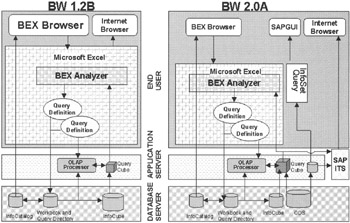Business Explorer Architecture
The overall intent of gathering data and constructing a data warehouse is to be able to access data for strategic and tactical decision-making processes. To build such an environment, SAP BW provides two major components known as the Business Explorer (BEX) Browser and BEX Analyzer. As mentioned in Chapter 2, the BEX Browser is used to publish available corporate information sets, such as a global repository of reports, documents, knowledge resources, and analytical applications. The BEX Analyzer is used to build analytical applications against SAP BW InfoCubes. These applications could be a simple query in Microsoft Excel or a combination of several worksheets in the form of a solution workbook using VBA programming to switch worksheets.
The BEX Browser is a Web-centric interface that presents analytical applications and reports. The BEX Browser acts very much like a portal to access information from diverse sources, including SAP BW. The BEX Browser directly communicates with InfoCatalog to identify target queries. If the target happens to be a BEX Analyzer application, BEX Browser will launch a Microsoft Excel session and transfer the query definition (metadata from the SAP BW metadata repository) to the BEX Analyzer. The BEX Analyzer is a Microsoft Excel-based interactive environment that defines and executes queries. When the user refreshes a BEX Analyzer query, the BEX Analyzer sends a request to the OLAP processor and the application server to fetch data. The OLAP processor decides how and from where to get data (InfoCube or Aggregate) to satisfy the query. The BW database server then sends data to the OLAP processor. The OLAP processor caches data in a virtual multidimensional cube for the end user (see the cube object at the application server layer in Figure 11-1). After building the virtual cube at the application server level, the OLAP processor sends the needed data to the BEX Analyzer (in Microsoft Excel) for further local analysis. At any moment during analysis, the user can save the current result back in the SAP BW database server for future use or mail it to other users if desired.

Figure 11-1: SAP BW Business Explorer Browser and Analyzer Architecture in BW 1.2B and BW 2.0A.
As shown in Figure 11-1, SAP BW 1.2B does not support pure Web reporting. You can publish a BW report (BEX Analyzer Excel with an embedded query) over the Internet; however, to do interactive anlysis, you need to install SAPGUI and SAP BW client components at the client workstation. In SAP BW 2.0, you can publish and execute pure Web queries by implementing the Web interface using the SAP Internet Transaction Server (ITS), as shown in Figure 11-1.
| Note | In SAP BW 2.0B GA, you will be able to build queries on the intranet. SAP will provide an ActiveX control called Query Builder. This Web Query Builder does not use a pure HTTP protocol. It requires an RFC connection to connect to the SAP BW instance, bypassing the Web server and restricted to Microsoft Internet Explorer 5.0 or later. |
In SAP BW 1.2B, you were unable to access data from ODS. In SAP BW 2.0, you can access data from ODS via BEX Analyzer or by using InfoSet Query (previously known as SAP Query). Notice in Figure 11-1 that you now have several choices to access data from SAP BW. In this chapter, you learn about how to develop queries and reports against SAP BW using Business Explorer. Key enhancements, InfoSet Query, and Web reporting are discussed in Appendix D, "Key Enhancements in SAP BW 2.0," and Operational Data Store in SAP BW 2.0 is discussed in Chapter 17, "The Operational Data Store in SAP BW 2.0."
| Team-Fly |
EAN: 2147483647
Pages: 174